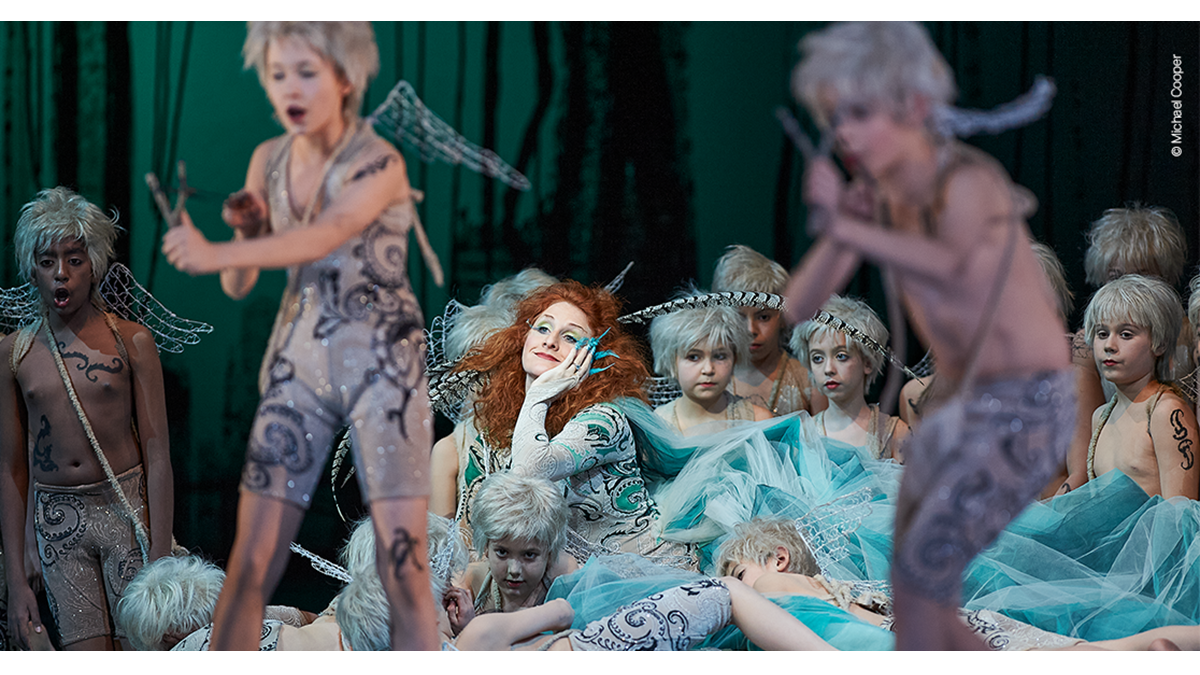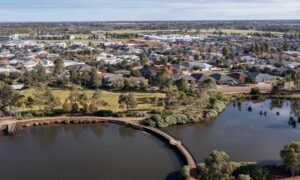An immersion of sound and sight, delivering both gravity and humour with exceptional skill
Presented by Adelaide Festival in association with Adelaide Symphony Orchestra
Reviewed 26 February 2020
A Midsummer Night’s Dream is perhaps one of Shakespeare’s most well-known plays, with innumerable adaptations for screen and stage, as well as the play being a staple of high school drama programs. However, this production of Britten’s operatic adaptation is like no other.
We are immediately transported to the mysterious and magical world of the fairies. The curtain rises to a silhouetted forest backdrop, young fairies swaying on the spot to the haunting portamentos of the string section. A huge translucent green sheet hangs suspended above the stage, rising and falling with the swells in the music. The combined effect makes it seem as though the stage itself is a living, breathing thing. Referred to in the program as the ‘veil of sleep’, the sheet is a strong indication of magic at work throughout the show, though it also serves to make everything under it appear small, and dare I say, “fairy-sized”.
The Adelaide Symphony Orchestra handle Britten’s score with their usual precision, under the baton of Paul Kildea. The string section in particular handle the delicate sliding music of the fairies as if with one bow. The cheer the orchestra received at the end of the show was more than well-deserved.
Young Adelaide Voices, as a legion of small fairies, start the show with voices pure and clear. These youth show as much professionalism on the stage as the adult performers, a testament to Christie Anderson’s masterful training. Tytania (Rachelle Durkin) and Oberon (Aryeh Nussbaum Cohen) appear shortly after and immediately begin their quarrel over the changeling boy. Cohen’s soaring countertenor is a wonder for the ears, and the moments of duet between him and Durkin are true musical highlights of the opera.
Puck, played by First Nations actor Mark Coles Smith, is also a delight. He is never still, his energy and physicality filling the immense Festival Theatre stage. The way he moves as though being controlled by Oberon’s magic late in Act 2 is an impressive feat of physical strength, agility and control.
The two pairs of lovers worked strongly as a quartet, their acting shining through as well as their singing. Special mention must go to Leanne Kenneally, whose Helena was tragically lovestruck (without the aid of fairy love juice) and suitably offended at the sudden changes in the men’s behaviour.
The rude mechanicals bumble around the stage, attempting to rehearse a show in an amateurish manner that may be all too familiar to those in the community theatre scene. Britten, not exactly known for his comedy in other works, has used each character’s vocal lines to good effect here, from the high pubescent tenor of Flute (Louis Hurley) to the slow, delayed lines of Snug (Pelham Andrews), which always drew a laugh from the audience.
Bottom (Warwick Fyfe) delivered his donkey transformation with braying vocal lines and deliberately grating moments that added to the humour of Tytania’s sudden love obsession with him, her grace and delicate vocals adding to the stark contrast between them.
There were too many impressive moments over the course of this three-hour opera to list them all, but one that must be mentioned is the performance of the rude mechanicals’ play in the third act. The performers excessive overacting and characterisation clearly portrayed the play-within-a-play, with admirable performances by “the wall” and “the moon” in particular.
The costuming is a beautiful complement to the set, making this show a true visual wonderland. Oberon and Tytania’s ornate outfits featured swirling green designs that tied in with the forested set and green veil of sleep. The human characters, by contrast, wore costumes styled after 1960s America, perhaps a nod to Brittain’s premiere of the opera in 1960. The utterly ‘ordinary’ styles, combined with colours such as pinks, reds and blues, stood out in stark contrast to the stylings of the forest and fairies. The message is crystal clear: the humans do not belong in this realm. The Duke’s wedding is coloured in elegant black, white and gold, with marble steps dominating the stage.
As with the set and costuming, colour is well thought through in the lighting, with particularly striking moments during the use of the love juice. Purple, traditionally considered to be the colour of magic, is shown here in the purple flower that Puck sprinkles over the unsuspecting lovers, complemented by purple light illuminating the affected individual. With purple appearing at no other point in the production, this affect is particularly striking and lighting designer Damien Cooper is to be commended on his work.
This production of Britten’s A Midsummer Night’s Dream is an immersion of sound and sight, delivering both gravity and humour with exceptional skill. The cast, orchestra, crew and creative team well and truly deserved the standing ovation on opening night.
Reviewed by Kristin Stefanoff
Twitter: @StefanoffK
Venue: Adelaide Festival Centre
Season: 26 Feb – 3 March 2021
Duration: 2hr 55min including interval
Tickets: $60 – $289
Bookings: https://www.adelaidefestival.com.au/events/a-midsummer-nights-dream/
Rating out of 5: 5





















